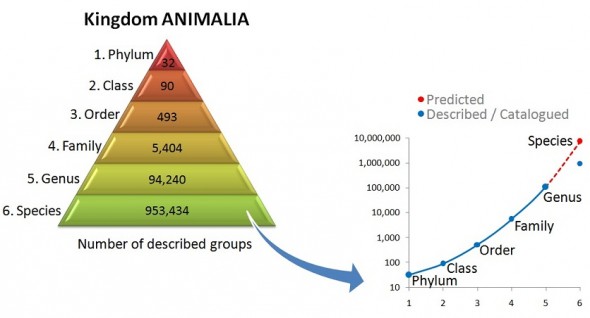Number of species alive today = 8.7 million. About a quarter of them live in the sea.
That’s the news from a study just out that examines what we don’t know about life on earth.
It means that should aliens come down and ask one of us “How many types of life there are on your planet, then?”, we shouldn’t have to shuffle our feet and look embarrassed. In all honesty, we don’t really know, but we can at least now hold our heads high and proclaim to have very good guess.
Camilo Mora (who led the recent study on the ineffectiveness of protected areas) and Boris Worm led a team that came up with the concept of tracing patterns among the species we already know and applying this across the board to come up with a new grand total for biological diversity, known and unknown.
Counting all the species on the planet is no mean feat. Even after the astounding achievements of programmes like the Census of Marine Life (who funded this current study) we’re still a long way off finding them all, let alone giving one each a name, figuring out what it is, how it works and where it belongs on the sprawling tree of life.
A timeworn shortcut is to take a well-informed estimate of how many we’ll find when (or if) we finally get around to tracking down the earth’s full complement of living biodiversity. And there are all sorts of ways scientists have had a go at this, including counting all the beetles living in a single rainforest tree, examining the bigness and smallness of things, and scooping up deep sea critters hiding in sea floor mud. Past estimates have ranged hugely from 3 to 100 million species. So this new total is by all accounts fairly conservative.
Mora and Worm’s approach didn’t involve gathering new data. Instead, they reached this new estimate via some clever number crunching.
To arrive at their 8.7 million estimate, the research team capitalized on their discovery of numerical patterns linking higher taxonomic ranks to species. Essentially, they looked at well known groups e.g. birds, fish and mammals, and found that the species number can be accurately predicted based on lower taxonomic ranks – classes, orders, and families. And that’s a huge bonus because the higher up the taxonomic ranks we climb, the more we currently know.
Rolling out the same patterns and predictions across lesser known corners of the living world, allowed them to put together their grand total of global biodiversity.
And why does it matter if we know how many species there are? I asked that exact question in my book about seahorses – who cares if there are 40 or 100 or 1000 species of seahorses in the world? (You’ll have to read it to find out my answer).
But for biodiversity in general, beyond the reasons of our better understanding ecology and ecosystems, of knowing how much we’re loosing, and all those practical, human-centric applications of food provision and so on, I’ve long thought there’s something deliciously nebulous and exciting about guessing how many species there might be out there. As an undergraduate, I loved learning about all the scientists who’ve gone out and given it a go, like Terry Erwin’s beetles and Fred Grassle’s muddy sea samples. I suspect there must be a little bit of the Victorian species-collector hiding in many of us.
And if Mora, Worm and co. are right about their 8.7 million, it means we still have to find 86% of all land species and 91% of all ocean species. And if we continue at our current species-naming pace, it’s going to take another 1200 years and US$364 billion to track them all down.
So, as the study authors point out, unless we radically shift our global outlook on protecting biodiversity, the chances are not all 8.7 million species will still be there when we get around to looking for them.



Leave a Reply